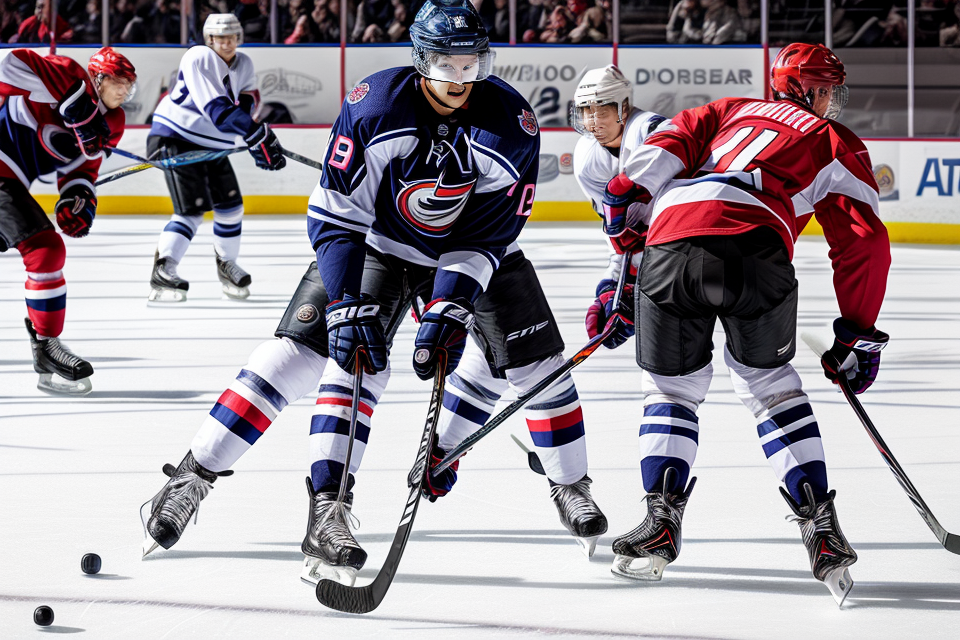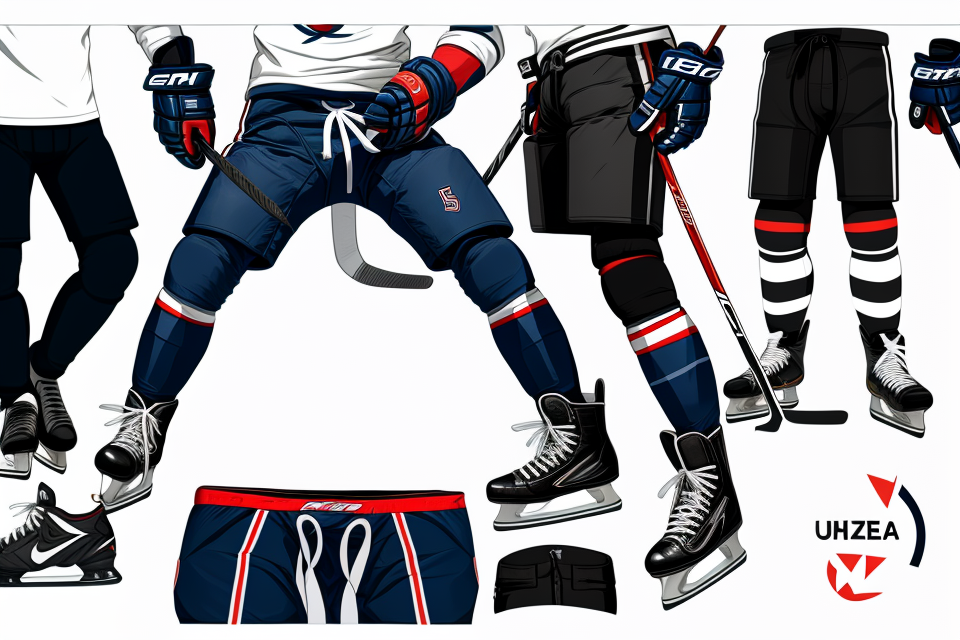Hockey is a fast-paced and physically demanding sport that requires players to be at the top of their game. One crucial piece of equipment that can make or break a player’s performance is their hockey pants. But how should hockey pants fit for optimal performance and comfort? In this article, we will explore the important factors to consider when choosing the right size and fit for your hockey pants. Whether you’re a seasoned pro or a beginner, understanding the importance of a proper fit can make all the difference on the ice. So, let’s dive in and find out what makes a great pair of hockey pants.
Hockey pants should fit snugly but comfortably around the thighs and hips, with a slightly tighter fit around the knees. They should not be too loose or too tight, as this can affect mobility and cause discomfort. The pants should also sit just above the knee, allowing for full range of motion and easy movement. It’s important to choose pants that are made from a breathable, moisture-wicking material to help keep you cool and dry during play. Additionally, the pants should have a secure and adjustable waistband to ensure they stay in place during play. Proper fitting hockey pants can help improve performance and reduce the risk of injury, so it’s important to take the time to get the right fit.
Factors Affecting Hockey Pants Fit
Body Type and Physical Characteristics
When it comes to selecting the right hockey pants, body type and physical characteristics play a crucial role in determining the appropriate fit. The following factors should be considered:
Height and Weight
The height and weight of a player are essential factors to consider when choosing hockey pants. Ideally, the pants should be long enough to cover the knees, and the hem should not rise above the mid-calf. In terms of weight, the pants should be heavy enough to provide adequate protection without being too heavy to hinder movement.
Muscle Mass and Body Composition
Muscle mass and body composition are also important factors to consider when choosing hockey pants. Players with more muscle mass may require pants with a larger waist and thigh circumference to ensure a secure fit. Additionally, players with a higher body fat percentage may require pants with a slightly looser fit to avoid restriction of movement.
Skeletal Frame and Joint Structure
The skeletal frame and joint structure of a player can also impact the fit of hockey pants. For example, players with longer legs may require pants that are longer in the inseam to prevent them from riding up during play. Additionally, players with wider hips may require pants with a slightly wider waistband to ensure a secure fit.
In conclusion, considering the body type and physical characteristics of a player is crucial when selecting hockey pants. A proper fit can help improve performance and comfort on the ice, while a poor fit can hinder movement and lead to discomfort.
Hockey Style and Position
Hockey style and position are crucial factors to consider when determining the appropriate fit for hockey pants. Different positions on the ice require varying degrees of mobility, balance, and flexibility, which directly impact the fit and comfort of the pants. Here are some key aspects to consider for each position:
Skating Technique
Forwards, defensemen, and goaltenders all have distinct skating techniques that influence the ideal fit of their hockey pants. For example, a forward may require greater mobility and range of motion in their hips and thighs for quick turns and speed, while a defenseman or goaltender may prioritize a tighter fit around the thighs for stability and support during battles along the boards.
Shot Power and Accuracy
The fit of hockey pants can also impact a player’s shot power and accuracy. For instance, a snug fit around the thighs can help generate more power behind a slap shot, while a looser fit may allow for more accuracy in wrist shots. Goaltenders, on the other hand, may benefit from a more form-fitting pant design that allows for better mobility and flexibility in their legs and hips while making saves.
Stickhandling and Puck Control
Hockey pant fit can also affect a player’s stickhandling and puck control skills. Tight-fitting pants can inhibit movement and limit the range of motion needed for deft stickhandling, while looser-fitting pants may cause the player to lose their balance or feel unstable on their skates. The ideal fit should provide enough support and flexibility to enable smooth puck handling and maintain control during high-speed play.
Proper Measurements for Hockey Pants
Waist Circumference
Measuring the waist circumference is an essential aspect of ensuring that your hockey pants fit you perfectly. It is crucial to take this measurement accurately to avoid any discomfort or restriction of movement while playing. Here are some measuring tips to follow:
Measuring Tips
- Stand up straight: Stand up straight with your feet shoulder-width apart and your hands on your hips. This position will help you to measure your waist circumference accurately.
- Use a flexible measuring tape: Use a flexible measuring tape, preferably one that is at least 60 inches long. Wrap the measuring tape around your waist, making sure it is snug but not too tight.
- Keep the tape level: Keep the measuring tape level around your waist, ensuring that it is parallel to the ground. Do not twist or pull the tape to get an accurate measurement.
- Take the measurement twice: Take the measurement twice, making sure to record the larger of the two measurements. This will ensure that you get an accurate reading of your waist circumference.
By following these measuring tips, you can ensure that your hockey pants fit you perfectly and provide you with the support and comfort you need on the ice.
Sizing Charts and Fit Guides
When it comes to finding the right size for your hockey pants, sizing charts and fit guides are essential tools to ensure that you get the perfect fit. However, it’s important to note that different brands and styles of hockey pants may have varying sizing charts and fit guides, so it’s crucial to refer to the specific brand or style you’re interested in.
Most brands provide sizing charts and fit guides on their websites or in-store, and they typically include measurements for waist, inseam, and thigh. These measurements can help you determine your appropriate size based on your body type and playing style.
It’s also important to keep in mind that sizing charts and fit guides are only a starting point. Each individual’s body shape and proportions are unique, so it’s crucial to try on the pants in person to ensure the best possible fit.
If you find that the hockey pants you’ve chosen don’t fit quite right, don’t be afraid to ask for alterations or customizations. Many hockey equipment retailers offer alteration services or can order pants in a specific length or waist size to ensure the perfect fit.
Try-On and Break-In Period
Trying on and breaking in your hockey pants is an essential part of ensuring they fit properly and provide optimal comfort and performance. Here are some factors to consider during this period:
Properly Inseam Length
The inseam length of your hockey pants should be the correct size for your height and leg length. The pants should fit snugly around your thighs without being too tight or too loose. A proper inseam length will also allow for full range of motion while skating.
Leg Padding and Comfort
Leg padding is an important feature of hockey pants, as it provides protection to the thighs and hips. The padding should be evenly distributed and not too bulky, as this can affect mobility. It’s essential to ensure that the padding is comfortable and doesn’t cause any discomfort or irritation.
Range of Motion and Mobility
Properly fitting hockey pants should not restrict your range of motion or mobility. The pants should allow for a full range of motion when skating, stopping, and turning. Try to perform various movements while trying on the pants to ensure that they don’t impede your movements.
Additionally, the waistband of the pants should be comfortable and provide support without being too tight. The hem of the pants should also be adjustable to ensure a snug fit around the calf.
It’s important to remember that breaking in your hockey pants is a process that may take some time. The pants may feel stiff or uncomfortable at first, but as you wear them more, they will eventually conform to your body and become more comfortable. It’s recommended to wear your hockey pants for at least a few practices or games before considering them fully broken in.
Optimal Fit for Enhanced Performance
Improved Speed and Agility
Quicker Transitions and Cuts
The right fit of hockey pants is crucial in ensuring that players can quickly transition and make cuts on the ice. Tight-fitting pants can impede movement, while baggy pants can cause friction and slow down the player. The ideal fit should allow for a full range of motion, with a slightly snug fit around the thighs and hips to provide support and stability during quick changes in direction.
Efficient Stride and Balance
A well-fitting pair of hockey pants can also help improve a player’s stride and balance on the ice. Loose-fitting pants can cause excess fabric to bunch up and impede the player’s movement, while tight-fitting pants can restrict circulation and cause discomfort. The ideal fit should provide a secure and comfortable feel around the thighs and hips, allowing for smooth and efficient strides, as well as better balance and control on the ice.
Increased Stability and Support
Enhanced stability and support are crucial components for optimal performance in hockey. Tight-fitting pants that provide ample support can significantly impact a player’s on-ice performance.
Enhanced Puck Control and Shot Accuracy
Properly fitting hockey pants can contribute to improved puck control and shot accuracy. When a player’s pants fit snugly, it enables them to maintain a low center of gravity, allowing for better balance and control over the puck. Tight-fitting pants also help in providing stability to the hips and thighs, enabling players to make quick movements and changes in direction. This increased stability allows for more precise movements, leading to improved shot accuracy and better puck control.
Reduced Risk of Injury
Hockey is a physically demanding sport that exposes players to a high risk of injuries. Properly fitting hockey pants can help reduce the risk of injury by providing enhanced support and stability to the lower body. Tight-fitting pants help in protecting the hips, thighs, and knees from impacts and collisions, which are common in hockey. Additionally, proper support helps in preventing excessive movement of the joints, reducing the risk of sprains, strains, and other injuries.
Reduced Fatigue and Discomfort
Better Airflow and Ventilation
One of the primary reasons that a proper fit in hockey pants is crucial is that it enhances airflow and ventilation. Tight-fitting pants can restrict airflow, causing discomfort and fatigue during long periods of play. In contrast, loosely fitting pants can become dislodged, exposing sensitive areas to injury. Therefore, a proper fit ensures that the pants stay in place and allow for adequate air circulation to prevent overheating and fatigue.
Easier Movement and Less Resistance
Hockey is a fast-paced game that requires quick movements and agility. Tight-fitting pants can hinder movement and cause resistance, making it difficult for players to change direction or move quickly. A proper fit allows for ease of movement, enabling players to make quick changes in direction and respond to on-field situations effectively. Additionally, loose-fitting pants can create additional drag, making it harder for players to maintain speed and agility.
In conclusion, a proper fit in hockey pants is essential for optimal performance and comfort. A snug fit that allows for better airflow and ventilation, as well as ease of movement, can help reduce fatigue and discomfort during long periods of play. By choosing the right size and style of hockey pants, players can ensure that they are able to perform at their best while remaining comfortable throughout the game.
Maintenance and Care
Proper maintenance and care of hockey pants are crucial to ensure optimal performance and prolong their lifespan. The following are some essential maintenance and care tips for hockey pants:
Regular Washing and Drying
Hockey pants should be washed regularly to remove sweat, dirt, and other debris that can accumulate during games and practices. It is recommended to wash them in cold water, as hot water can cause shrinkage and damage to the materials. Additionally, it is advisable to wash them inside out to prevent damage to the pockets and other details.
After washing, the pants should be dried thoroughly to prevent the buildup of mildew and other odors. It is recommended to air-dry them or use a low heat setting in the dryer. However, it is important to avoid using high heat settings or any fabric softeners, as they can cause damage to the materials.
Repairs and Replacements
Hockey pants may sustain damage during games or practices, such as tears or rips in the fabric. It is essential to repair them promptly to avoid further damage and ensure they fit properly. Minor repairs can be done at home using patches or thread, while more significant repairs may require professional assistance.
In cases where the damage is too extensive, and repairs are not feasible, it may be necessary to replace the pants entirely. When selecting a replacement, it is important to consider factors such as fit, comfort, and durability.
Proper Storage and Hanging
Proper storage of hockey pants is also crucial to ensure they maintain their shape and fit for extended periods. It is recommended to store them in a cool, dry place, away from direct sunlight. Additionally, it is advisable to hang them on a sturdy hanger to prevent creasing and other types of damage.
By following these maintenance and care tips, hockey players can ensure their pants fit well, provide optimal performance, and last longer.
Importance of Properly Fitted Hockey Pants
Enhanced Performance
Hockey is a fast-paced and physically demanding sport that requires quick movements and agility. The right fit of hockey pants is crucial for optimal performance as it allows for unrestricted movement and flexibility. Tight-fitting pants can cause discomfort and restrict movement, while loose-fitting pants can cause distractions and impede performance. Therefore, properly fitted hockey pants can enhance performance by providing comfort and allowing for maximum movement.
Longer Lifespan
In addition to enhancing performance, properly fitted hockey pants can also increase the lifespan of the equipment. Ill-fitting pants can cause wear and tear on the fabric and seams, leading to a shorter lifespan. By ensuring that the pants fit correctly, the lifespan of the equipment can be extended, reducing the need for frequent replacements and saving money in the long run.
Personal Comfort and Satisfaction
Beyond the practical benefits, properly fitted hockey pants can also contribute to personal comfort and satisfaction. Players who are comfortable and confident in their equipment are more likely to perform at their best and enjoy the game. Ill-fitting pants, on the other hand, can cause discomfort and distractions, negatively impacting performance and enjoyment. Therefore, it is important to prioritize a proper fit when selecting hockey pants for optimal performance and personal satisfaction.
FAQs
1. What are the key factors to consider when determining the right fit for hockey pants?
When determining the right fit for hockey pants, the key factors to consider are the size of the pants, the waist size, the inseam length, and the flexibility of the pants. It is important to choose pants that fit comfortably and allow for full range of motion on the ice.
2. How do I measure my waist size for hockey pants?
To measure your waist size for hockey pants, measure the circumference of your natural waistline using a flexible tape measure. This should be done with your pants on and your hands on your hips. The measurement should be taken at the belly button level.
3. How do I measure the inseam length of hockey pants?
To measure the inseam length of hockey pants, measure from the bottom of the thigh to the top of the skate. This measurement should be taken with the pants laid flat and the legs straight.
4. What should I look for in terms of flexibility when choosing hockey pants?
When choosing hockey pants, it is important to look for pants that have a high level of flexibility. This will allow for full range of motion on the ice and prevent any restriction in movement.
5. How do I know if my hockey pants are the right size?
If your hockey pants are the right size, they should fit comfortably and not be too tight or too loose. The pants should also allow for full range of motion on the ice. If you are unsure if your pants are the right size, try them on and take a few practice laps around the rink to see how they feel.



